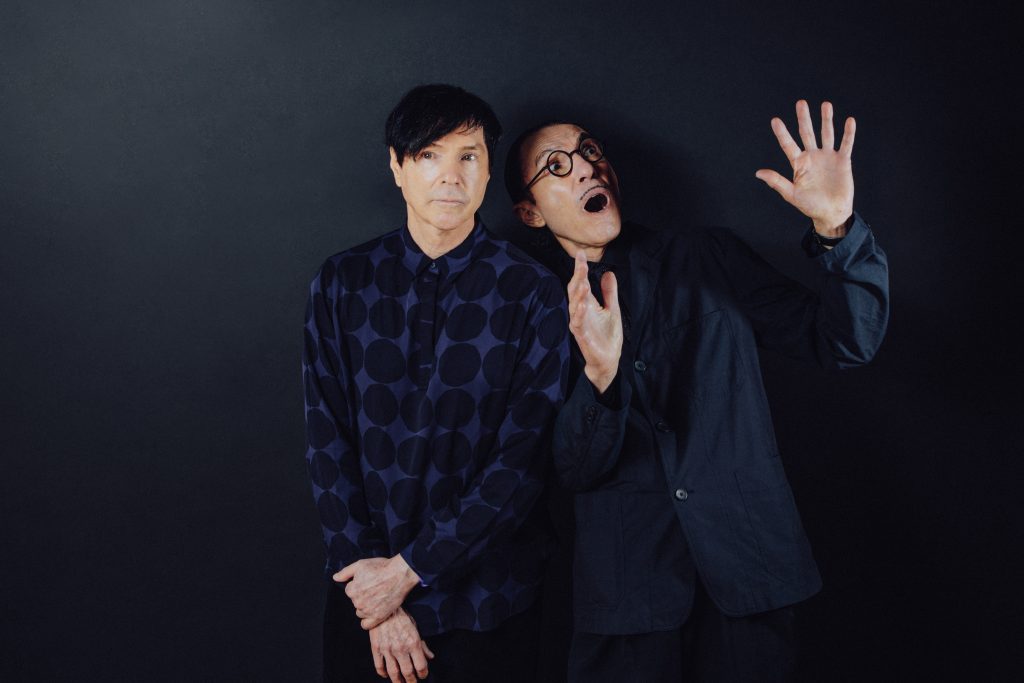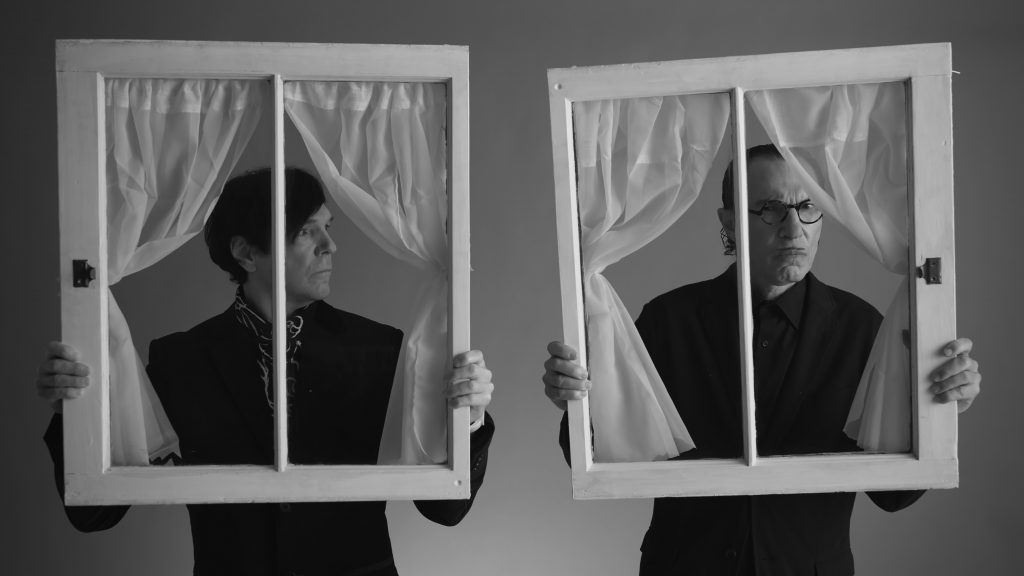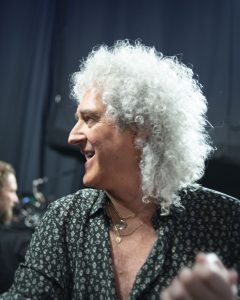November 3, 2022
by Carla Hay
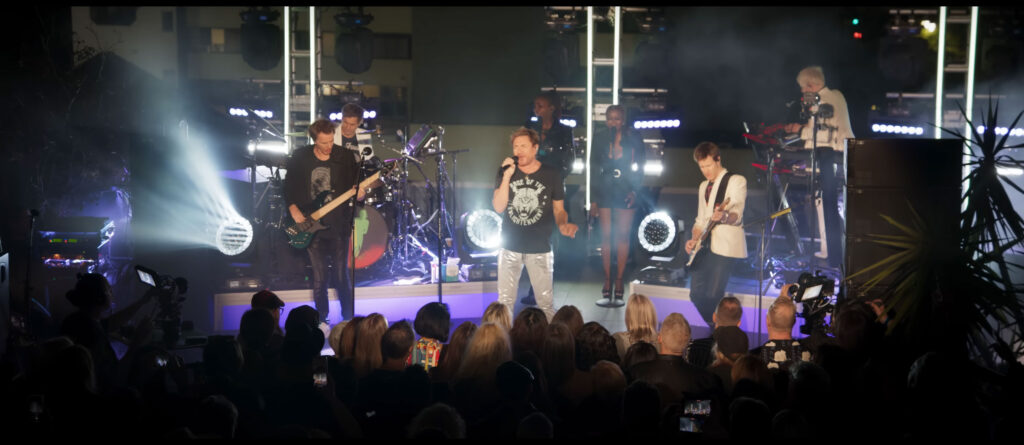
“Duran Duran: A Hollywood High”
Directed by Gavin Elder, Vincent Adam Paul and George Scott
Culture Representation: Taking place in Los Angeles in March 2022, the documentary film “Duran Duran: A Hollywood High” features British pop/rock band Duran Duran performing the group’s first rooftop concert.
Culture Clash: In the documentary interviews, members of the band talk about the culture shock they experienced the first time they visited and performed in Los Angeles.
Culture Audience: Besides the obvious target audience of Duran Duran fans,“Duran Duran: A Hollywood High” will appeal primarily to fans of pop music artists who had their biggest hits in the 1980s.
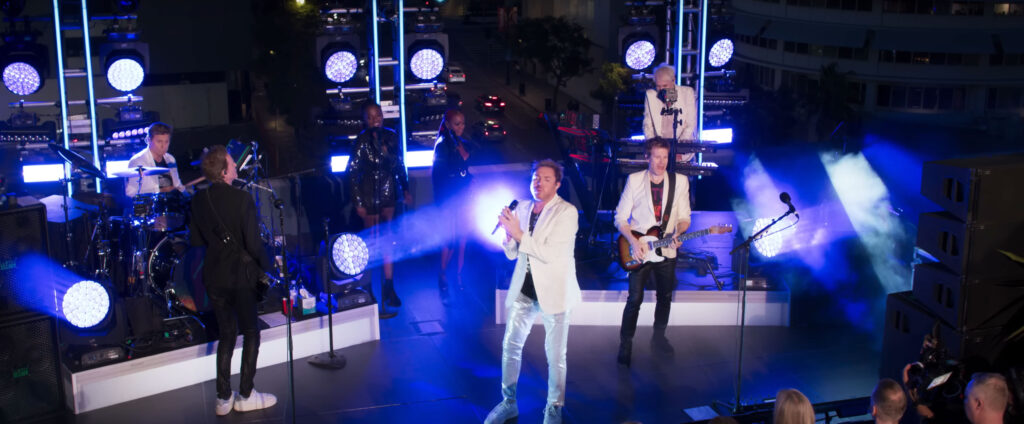
Even though the British pop/rock band Duran Duran is mostly known for the band’s hits from the 1980s, the concert documentary “Duran Duran: A Hollywood High” is an admirable showcase of a still-vibrant Duran Duran performing songs from the 1980s to the 2020s. This 75-minute documentary is good but not outstanding or comprehensive. Avid fans of Duran Duran will consider this movie a must-see. Everyone else might watch out of curiosity to see the 2022 version of Duran Duran and what kind of live performance the band has to offer, 41 years after Duran Duran’s 1981 self-titled debut album was released.
Directed by Gavin Elder, Vincent Adam Paul and George Scott, “Duran Duran: A Hollywood High” at least has a unique concert setting for Duran Duran, because it shows the band performing its very first rooftop concert. The documentary was filmed in March 2022, at The Aster (a hotel and members’ club) in Los Angeles’ Hollywood district. The concert took place months before The Aster officially opened in October 2022. About 200 to 250 people were in the audience of this concert.
This particular concert location was chosen because The Aster is across the street from the iconic Capitol Records building, whose famous circular shape is designed to look like stacked vinyl records on a turntable. Capitol Records was the U.S. record label for Duran Duran from 1981 to 1999, the years when the band had its biggest hits. During the concert film, there are several sweeping shots of the band performing with the Capitol Records building as a backdrop.
The documentary begins with an approximately 15-minute introduction of background information (a mixture of archival footage and new footage) explaining Duran Duran’s history with Los Angeles. Duran Duran formed in 1978, in Birmingham, England. Bass player John Taylor and keyboardist Nick Rhodes co-founded the band; drummer Roger Taylor (no relation to John Taylor) joined in 1979; and lead singer Simon LeBon joined in 1980. Roger Taylor quit in 1986, and John Taylor quit in 1997, but both Taylors have been part of Duran Duran’s reunited lineup since 2001.
The documentary very briefly mentions Andy Taylor (no relation to John Taylor and Roger Taylor), who was Duran Duran’s guitarist from 1980 to 1986, and from 2001 to 2006. Since 2006, Dominic “Dom” Brown has been Duran Duran’s touring and recording guitarist. In the documentary, Rhodes has high praise for American guitarist Warren Cuccurullo, who worked with Duran Duran from 1986 to 2001. Rhodes says meeting Cuccurullo for the first time in Los Angeles was the most important and impactful meeting that Duran Duran ever had in Los Angeles.
In the documentary, Roger Taylor says in an exclusive interview that his experience of visiting Los Angeles for the first time in 1981 was almost like being in another world, because Los Angeles is so different from Birmingham, England. He mentions that sunshine and palm trees “are in real short supply” in Birmingham. And he remembers what his first impression was of Los Angeles: “I thought I’d arrived in paradise.”
Rhodes comments that when he thinks of Los Angeles, he always thinks of the Sunset Strip and Los Angeles’ obsession with fame. Two iconic Sunset Strip buildings are mentioned in this introduction: The Roxy nightclub (the first venue in Los Angeles that Duran Duran played during the band’s 1981 U.S. tour) and the now-defunct Continental Hyatt House, which was nicknamed the Continental Riot House, because it was a notorious party spot for rock stars and other celebrities. (The hotel has been renamed several times and has been known as the Andaz West Hollywood since 2009.) In true rock-star fashion, Duran Duran was expelled from the Continental Hyatt for some troublemaking antics during the band’s first U.S. tour. John Taylor, who has lived in Los Angeles since the 1990s, comments that Los Angeles is “a very uplifting place to be.”
LeBon says that New York City and Los Angeles are so different from each other, they’re like separate planets. He compares New York City to being like the grit of punk rock, and Los Angeles to being like the decadence of rock and roll. LeBon shares a vivid first-impression memory of Los Angeles having oil rig machines and an immense number of billboards on the Sunset Strip.
“I’d never seen so much commercial advertising,” he recalls. LeBon also says that Nina Simone was invited to Duran Duran’s first Los Angeles show, but she couldn’t attend. However, she sent him a hand-written note with an apology that she couldn’t be there and to wish Duran Duran the best. LeBon says he still has the note, and it’s one of his most-treasured possessions.
In addition to the documentary having archival footage of Duran Duran in Los Angeles (including the band’s 1984 press conference at Magic Castle Hotel and the band’s 1993 ceremony to get a star on the Hollywood Walk of Fame), “Duran Duran: A Hollywood High” includes a brief new clip of Rhodes talking with music producer David Kershenbaum, who remixed the band’s 1982 album “Rio,” which became Duran Duran’s international breakthrough album after the album was remixed. Rhodes expresses gratitude to Kershenbaum for playing a pivotal role in Duran Duran’s career. Kershenbaum comments on working with Duran Duran in the early 1980s, “It was a magical time.”
If all of this sounds like the documentary is on a nostalgia trip, think again. The concert, which is the majority of “Duran Duran: A Hollywood High,” has a range of Duran Duran songs from the 1980s to tracks from the band’s 2021 album “Future Past.” Clad in black and white outfits, Duran Duran (accompanied by backup singers Anna Ross and Erin Stevenson) perform a setlist that’s not really a greatest-hits collection but more like a hodgepodge of Duran Duran songs from the 1980s, 1990s and the early 21st century.
The 12 songs performed in the documentary are (in order):
- “A View to a Kill” (1985)
- “Invisible” (2021)
- “All of You” (2021)
- “Notorious” (1986)
- “Come Undone” (1993)
- “Give It All Up” (2021)
- “Pressure Off” (2015)
- “White Lines” (1995)
- “Anniversary” (2021)
- “Ordinary World” (1993)
- “Tonight United” (2021)
- “Hungry Like the Wolf” (1982)
The concert begins with a lot of great energy, but it really starts to hit its stride when Duran Duran performs “Notorious.” Backup singers Ross and Stevenson get their moments to shine with solo refrains in songs (Ross on “Come Undone,” Stevenson on “Give It All Up”), while guitarist Brown has a standout moment with his soloing in “Ordinary World.” Because the stage is so small, John Taylor, LeBon and Brown don’t do a lot of running around back and forth and basically stay in the same positions on the stage.
The documentary’s cinematography stays mainly focused on stage, with a fair balance of wide shots and close-ups of the band members. Any glimpses of the audience are very brief, so as not to distract the documentary viewers from what’s happening on stage. There are multiple shots of keyboardist Rhodes, a longtime photographer, taking photos and videos on his phone from his vantage point behind the keyboards. The movie’s sound editing and sound mixing get the job done well enough, but nothing in this documentary is exceptional enough to be award-worthy.
The concert’s energy level is at its peak with Duran Duran’s blistering cover version of Melle Mel’s “White Lines” that the band turns into a stellar dance-rock party song. The band’s poignant rendition of “Ordinary World” is an example of why this ballad is a timeless Duran Duran classic. “Tonight United” and fan fave “Hungry Like the Wolf” were among the other standout performances. The main drawback to the documentary is that it seems too short, considering all the beloved Duran Duran songs that could have been in the movie but aren’t.
The vocals of many lead singers of rock bands usually don’t get better with age, but LeBon’s voice as a live performer has better tone and control than it did in the 1980s. LeBon, Roger Taylor, John Taylor and Rhodes are still solid and stylish performers, but understandably not as flashy and prone to doing the expected rock-star stage moves that were part of Duran Duran’s act in the 1980s. In other words, Duran Duran is aging gracefully and can still deliver a concert that’s worthy of the band’s memorable songs and unique sound.
Abramorama in association with Fathom Events released “Duran Duran: A Hollywood High” for a limited engagement in U.S. cinemas on November 3, 2022.

